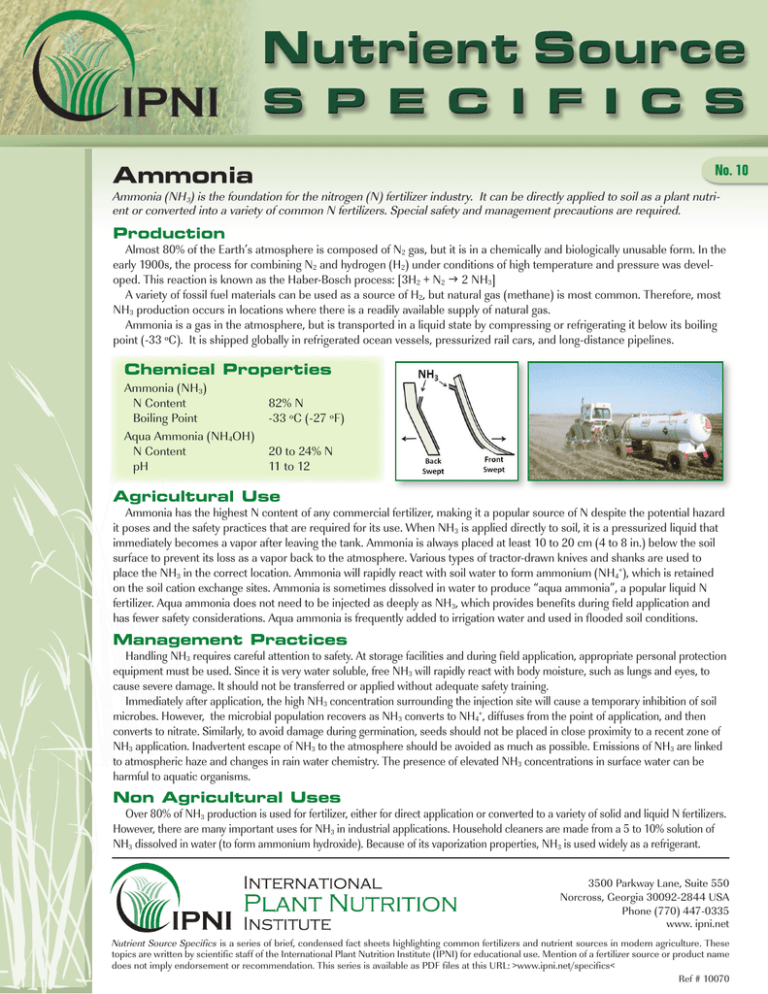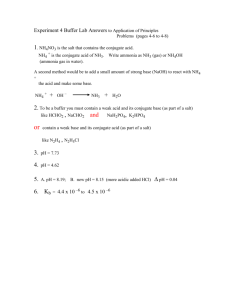Ammonia
advertisement

Ammonia No. 10 Ammonia (NH3) is the foundation for the nitrogen (N) fertilizer industry. It can be directly applied to soil as a plant nutrient or converted into a variety of common N fertilizers. Special safety and management precautions are required. Production Almost 80% of the Earth’s atmosphere is composed of N2 gas, but it is in a chemically and biologically unusable form. In the early 1900s, the process for combining N2 and hydrogen (H2) under conditions of high temperature and pressure was developed. This reaction is known as the Haber-Bosch process: [3H2 + N2 g 2 NH3] A variety of fossil fuel materials can be used as a source of H2, but natural gas (methane) is most common. Therefore, most NH3 production occurs in locations where there is a readily available supply of natural gas. Ammonia is a gas in the atmosphere, but is transported in a liquid state by compressing or refrigerating it below its boiling point (-33 ºC). It is shipped globally in refrigerated ocean vessels, pressurized rail cars, and long-distance pipelines. Chemical Properties Ammonia (NH3) N Content 82% N Boiling Point -33 ºC (-27 ºF) Aqua Ammonia (NH4OH) N Content 20 to 24% N pH11 to 12 Agricultural Use Ammonia has the highest N content of any commercial fertilizer, making it a popular source of N despite the potential hazard it poses and the safety practices that are required for its use. When NH3 is applied directly to soil, it is a pressurized liquid that immediately becomes a vapor after leaving the tank. Ammonia is always placed at least 10 to 20 cm (4 to 8 in.) below the soil surface to prevent its loss as a vapor back to the atmosphere. Various types of tractor-drawn knives and shanks are used to place the NH3 in the correct location. Ammonia will rapidly react with soil water to form ammonium (NH4+), which is retained on the soil cation exchange sites. Ammonia is sometimes dissolved in water to produce “aqua ammonia”, a popular liquid N fertilizer. Aqua ammonia does not need to be injected as deeply as NH3, which provides benefits during field application and has fewer safety considerations. Aqua ammonia is frequently added to irrigation water and used in flooded soil conditions. Management Practices Handling NH3 requires careful attention to safety. At storage facilities and during field application, appropriate personal protection equipment must be used. Since it is very water soluble, free NH3 will rapidly react with body moisture, such as lungs and eyes, to cause severe damage. It should not be transferred or applied without adequate safety training. Immediately after application, the high NH3 concentration surrounding the injection site will cause a temporary inhibition of soil microbes. However, the microbial population recovers as NH3 converts to NH4+, diffuses from the point of application, and then converts to nitrate. Similarly, to avoid damage during germination, seeds should not be placed in close proximity to a recent zone of NH3 application. Inadvertent escape of NH3 to the atmosphere should be avoided as much as possible. Emissions of NH3 are linked to atmospheric haze and changes in rain water chemistry. The presence of elevated NH3 concentrations in surface water can be harmful to aquatic organisms. Non Agricultural Uses Over 80% of NH3 production is used for fertilizer, either for direct application or converted to a variety of solid and liquid N fertilizers. However, there are many important uses for NH3 in industrial applications. Household cleaners are made from a 5 to 10% solution of NH3 dissolved in water (to form ammonium hydroxide). Because of its vaporization properties, NH3 is used widely as a refrigerant. 3500 Parkway Lane, Suite 550 Norcross, Georgia 30092-2844 USA Phone (770) 447-0335 www. ipni.net Nutrient Source Specifics is a series of brief, condensed fact sheets highlighting common fertilizers and nutrient sources in modern agriculture. These topics are written by scientific staff of the International Plant Nutrition Institute (IPNI) for educational use. Mention of a fertilizer source or product name does not imply endorsement or recommendation. This series is available as PDF files at this URL: >www.ipni.net/specifics< Ref # 10070






